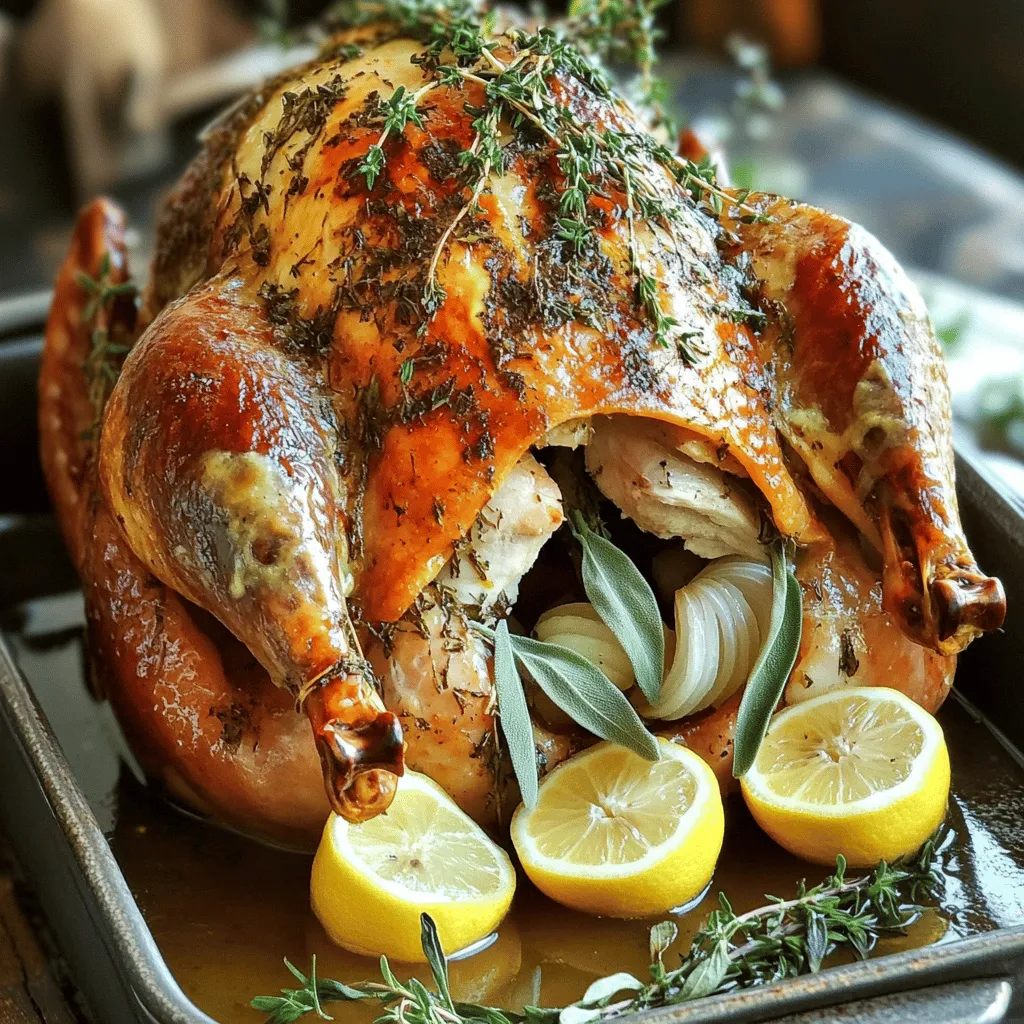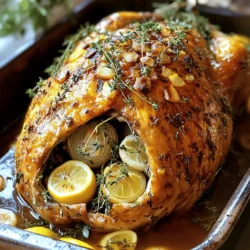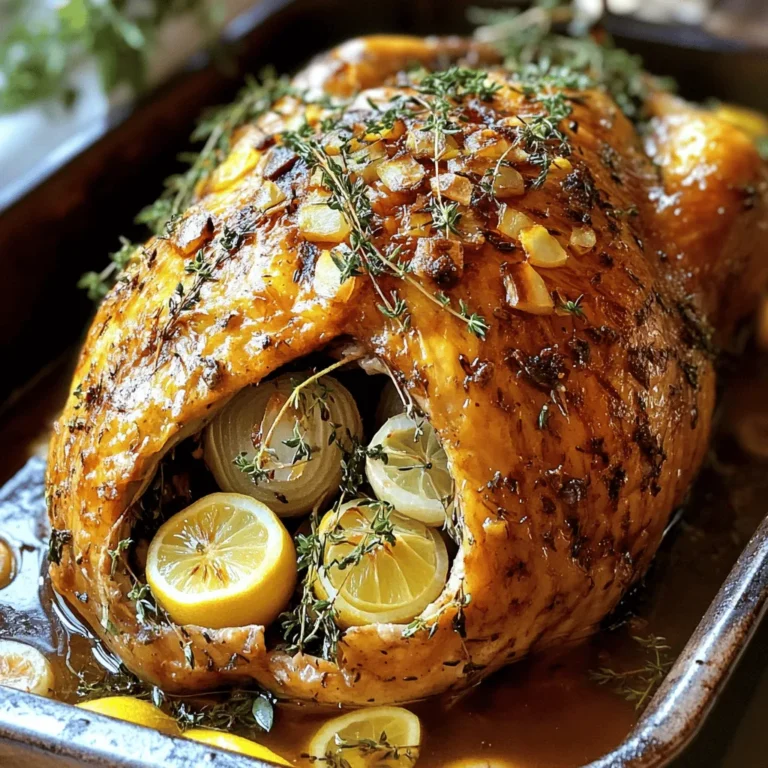Are you ready to impress your guests with a roast turkey that’s flavorful and juicy? In this post, I’ll share my secret recipe for Gordon Ramsay Style Roast Turkey. With simple ingredients and straightforward steps, I’ll guide you in creating a perfectly seasoned bird that shines on any table. Let’s dive into the world of cooking and get that turkey roasting like a pro!
Ingredients
Main Ingredients for Gordon Ramsay Style Roast Turkey
To create a flavorful and juicy turkey, you will need:
– 1 whole turkey (12-14 pounds)
– 4 tablespoons unsalted butter, softened
– 1 tablespoon olive oil
– 1 tablespoon kosher salt
– 1 teaspoon freshly cracked black pepper
– 2 lemons (zested and juiced)
– 1 tablespoon fresh thyme, finely chopped
– 1 tablespoon fresh rosemary, finely chopped
– 1 tablespoon fresh sage, finely chopped
– 1 large onion, quartered
– 4 cloves garlic, smashed
– 2 cups low-sodium chicken broth
– Fresh herbs for garnish (thyme and rosemary)
Seasoning and Flavor Enhancers
The right seasoning makes a huge difference. Use kosher salt and freshly cracked black pepper to bring out the turkey’s flavor. Fresh herbs like thyme, rosemary, and sage add a lovely aroma. The lemon juice and zest help brighten the taste.
Optional Garnishes and Stuffing Ingredients
You can enhance your turkey with optional garnishes and stuffing. Consider adding:
– Extra fresh herbs (thyme and rosemary) for garnish
– Stuffing made from bread, vegetables, and herbs
– Additional garlic for a stronger flavor
Using these ingredients will ensure your Gordon Ramsay Style Roast Turkey is not just tasty but also visually stunning.
Step-by-Step Instructions
Preparation and Preheating
First, preheat your oven to 325°F (165°C). This step warms the oven for even cooking. Next, remove the giblets from inside the turkey. You can discard them or save them for another dish. Use paper towels to dry the turkey well. This helps the skin get crispy during roasting.
Creating the Herb Butter Mixture
Now, let’s make the herb butter. In a bowl, mix the softened butter, olive oil, kosher salt, and black pepper. Add the lemon zest, chopped thyme, rosemary, and sage. Stir until smooth. This butter will add great flavor to your turkey.
Seasoning and Filling the Turkey
With clean hands, gently pull the skin away from the turkey meat, especially on the breast. Take half of the herb butter and spread it under the skin. Make sure it covers the meat well for the best taste. Next, rub the rest of the butter all over the outside of the turkey. Stuff the cavity with the quartered onion, smashed garlic, and lemon halves. This mix adds aroma and flavor during roasting.
Roasting Techniques and Timing
Pour chicken broth into the bottom of a large roasting pan. This broth keeps the turkey moist while cooking. Place the turkey, breast side up, in the pan. Tie the legs together with kitchen twine and tuck the wing tips beneath the turkey. This helps it cook evenly. Roast the turkey, basting it with the pan juices every 30 minutes. Cook for about 13-15 minutes per pound. The turkey is ready when the thickest part of the breast and thigh reaches 165°F (74°C).
Once cooked, let the turkey rest for at least 30 minutes before carving. This keeps the juices inside the meat. Then, slice it and serve with your favorite sides. For a nice touch, garnish with fresh herbs.
Tips & Tricks
Ensuring Crispy Skin on the Turkey
To get that perfect crispy skin, start with a dry turkey. Pat it dry with paper towels. This helps the skin crisp up. Next, use a mix of butter and oil to coat the skin. The fat will help it brown nicely. Make sure to season under the skin too. This adds flavor and moisture, keeping it juicy.
Proper Basting Techniques
Basting is key for a moist turkey. Use the pan juices to baste every 30 minutes. This keeps the skin from drying out. Basting also adds flavor to the meat. When you baste, use a ladle or spoon. Pour the juices over the turkey, covering all parts. Avoid opening the oven too often. Each time you do, heat escapes, making it cook longer.
How to Check for Doneness
Check for doneness using a meat thermometer. Insert it into the thickest part of the breast. The turkey is done when it reaches 165°F (74°C). You can also check the thigh. If the juices run clear, it’s ready. Let it rest after cooking. This allows the juices to stay inside, making it more flavorful.

Variations
Herb Blend Alternatives
If you want to change the herb mix, try different flavors. You can use herbs like basil, oregano, or parsley. These add unique tastes to your turkey. For a spicy kick, add some crushed red pepper flakes. This twist can make your meal more exciting.
Cooking Methods
You can explore various cooking methods for your turkey. Brining is a great way to keep the meat juicy. Soak the turkey in a saltwater solution overnight. This adds moisture and flavor.
Grilling is another fun option. It gives the turkey a smoky flavor. Just be sure to monitor the heat. You want to cook it evenly without burning the skin.
Seasonal Flavor Additions
Seasonal additions can enhance your turkey’s taste. In fall, add cranberries or apples to the stuffing. These fruits bring sweetness and a hint of tartness. In winter, try using citrus fruits like oranges or grapefruits. Their bright flavors can brighten up a cold day.
For the holidays, consider using spices like cinnamon or nutmeg. These warm spices can add a festive touch. You can adjust the recipe to suit your taste or the season. With these ideas, your Gordon Ramsay style roast turkey will be a hit at any gathering.
Storage Info
How to Store Leftover Roast Turkey
After your meal, let the turkey cool. Place it in a shallow dish. Cover it tightly with plastic wrap or aluminum foil. This keeps it fresh. You can also use airtight containers. Store the turkey in the fridge. It’s best to eat it within three to four days.
Reheating Methods for Best Results
To reheat your turkey, avoid drying it out. Preheat your oven to 325°F (165°C). Place the turkey in a baking dish. Add a splash of broth or water to keep it moist. Cover the dish with foil. Heat for about 20-30 minutes. Check if it’s warm all the way through. You can also use a microwave. Slice the turkey and place it on a microwave-safe plate. Cover it with a damp paper towel. Heat in short bursts, checking often.
Freezing Tips for Extended Freshness
If you have more turkey than you can eat, freeze it! First, carve the turkey. Place the meat in freezer bags. Remove as much air as possible. Label the bags with the date. Freeze for up to six months. When you’re ready to eat, thaw in the fridge overnight. Reheat as mentioned above for the best taste. Enjoying leftover turkey can be as good as the first meal!
FAQs
What is the ideal cooking temperature for turkey?
The best cooking temperature for turkey is 325°F (165°C). This temperature cooks the turkey evenly, keeping it juicy and flavorful. It’s also the safe temperature to kill harmful bacteria. Use a meat thermometer to check the internal temperature. The thickest part of the breast and thigh should reach 165°F (74°C).
How long should I let the turkey rest before carving?
Let the turkey rest for at least 30 minutes before carving. Resting allows the juices to spread throughout the meat. This makes each slice juicy and tender. If you carve too soon, the juices may run out, leaving you with dry meat.
Can I prepare the herb butter ahead of time?
Yes, you can prepare the herb butter a day or two in advance. Just mix the ingredients and store it in the fridge. This not only saves time but also allows the flavors to blend well. When ready, just take it out and let it soften before using.
What sides pair well with Gordon Ramsay Style Roast Turkey?
Many sides pair well with roast turkey. Here are some great options:
– Mashed potatoes
– Green bean casserole
– Cranberry sauce
– Stuffing
– Roasted vegetables
– Gravy
These sides complement the turkey’s flavors and complete your feast.
Roasting a turkey in Gordon Ramsay’s style brings out rich flavors and crispy skin. We covered the key ingredients, from herb butter to seasoning. The step-by-step guide helps you master the roasting process. Tips for crispy skin and checking doneness ensure great results. Variations let you customize your turkey with different herbs or cooking methods. Finally, proper storage allows you to enjoy leftovers later. Cooking a roast turkey not only delights your guests but also makes for a special meal worth sharing. Enjoy your turkey and the joy it brings!


